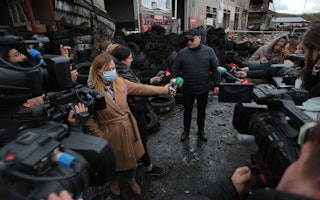How to Protect Journalists in Pakistan
By Asad Khalid Baig
Published on May 23 of this year, Inside Al-Qaeda and the Taliban: Beyond Bin Laden and 9/11 was applauded for bringing to light the threats posed by extremism to Pakistan’s stability. Written by globally recognized and respected investigative journalist Saleem Shahzad, the book focuses on the new generation of Al-Qaeda leaders behind recent terrorist attacks, including Mumbai in 2008.
Shahzad followed this with an article in the Asia Times that pointed out affiliates of Al-Qaeda operating deep within the ranks of the Pakistan Navy. The next day, on his way to a TV interview, he was abducted by as yet unidentified persons. The following morning he was found dead on the roadside of a remote village. He had been tortured to death.
A judicial commission is currently investigating Shahzad’s death, and Pakistan’s intelligence agencies have been accused of playing a role in the tragedy. The agencies and the representatives of Inter Services Public Relations (ISPR, which handles PR for the Pakistan Defence Forces) have denied any involvement.
Shahzad’s case is not a lone incident; he was among 76 Pakistani journalists who have lost their lives during the last 10 years. The Committee to Protect Journalists (CPJ) and the International Federation of Journalists (IFJ) have both declared Pakistan the most dangerous country for journalists—more perilous than Mexico, Afghanistan, and Iraq. One would assume the larger percentage of deceased would be from tribal and conflict regions, but according to CPJ, 53 percent of them were covering political beats, mostly in metropolitan areas.
Freedom of media and speech is imperative to a free and democratic society, but high-level threats facing journalists in Pakistan have made it extremely challenging to report impartially. According to CPJ stats, complete impunity exists in 95 percent of the cases of murdered journalists.
The first and the most obvious step to ensure journalists’ safety is the provision of justice in the preceding 76 killings. Another aspect to be addressed is the lack of basic survival training and equipment. From a single state-owned channel in the year 2000 to more than 70 privately owned electronic news organizations, Pakistan's media has grown tremendously in a very short time. Young camera persons and reporters are sent to conflict regions without appropriate training and equipment. Driven by the desire to be the “first on spot,” they often ignore all signs of mortal danger in their effort to get closer for a better shot and a story. Improvised bomb-attacks haven’t helped either. In a recent bomb blast in Peshawar, when the journalists arrived, another bomb went off which likely was intended to kill the lot of them.
Civil society can play a significant role in advocating for the safety of Pakistan's journalists in a number of ways, including:
- bringing the major stakeholders, i.e. media houses/owners, journalist associations, and practitioners on board to help build consensus on safety protocols;
- working to end impunity and to bring justice to the families of deceased;
- imparting basic conflict-sensitive reporting skills and survival techniques essential for hostile environments to journalists working all around the country.
International Media Support (IMS), a Denmark-based nonprofit working to support local media in countries affected by armed conflict, along with its local partners Intermedia, Pakistan Institute for Peace Studies (PIPS), and the Pakistan Federal Union of Journalists (PFUJ), is conducting an extensive three-year project to improve safety conditions for journalists in Pakistan. The project focuses on developing safety protocols, consensus-building among stakeholders, conflict-sensitive reporting and survival trainings, advocacy on safety, and lobbying to end impunity.
A conference, “Keeping Journalists and Journalism Safe in Hostile Environment,” recently organized by Intermedia and PFUJ in Islamabad, was a part of the IMS safety project. It brought together representatives of leading national and international media houses, media managers, practitioners, and representatives of media development organizations to build consensus on the extraordinary measures required to counter the threat level.
Publications presented during the conference included a safety guide for journalists and the report “Media Under Threat in Baluchistan.” The challenges of reporting in and from conflict regions and the best practices of conflict-sensitive journalism came under discussion in a variety of sessions. Absar Alam, country director of the Foundation Open Society Institute–Pakistan, presented a session to identify setbacks and a way forward to improve safety conditions and ensure impartial journalism.
The results of this event were impressive: five national and three regional media groups agreed on safety protocols developed by IMS and Intermedia; a proposed bill for journalists’ safety, to be drafted by IMS and Intermedia lawyers, will be presented in Parliament by the interior minister; and consensus on a “Declaration of Safety,” outlining the respective roles of media associations, owners, and practitioners in protecting the journalists.
IMS plans to hold activities tailored around the declaration, to ensure its implementation in the coming year. IMS and Intermedia have also stepped up to create a cadre of local trainers to devise manuals and conduct trainings that are customized to the sensitivities and needs in Pakistan's main conflict zones.
The targeting of journalists is the targeting of free media and free speech. Urgent measures need to be taken in Pakistan. While the IMS initiatives are commendable, others need to join in to make the safety procedures more sustainable. For maximum impact and to coordinate efforts, one option is a coalition of national and international civil society organizations and major stakeholders such as media houses, journalist unions, and practitioners.
Seventy-six murdered journalists’ families are awaiting justice, and the culture of impunity cannot end without the active presence of an influential pressure group. A coalition could provide a substantial first step towards a safe environment for free journalism.
Until April 2015, Asad Baig was assistant manager of administration at the Foundation Open Society Institute–Pakistan.


